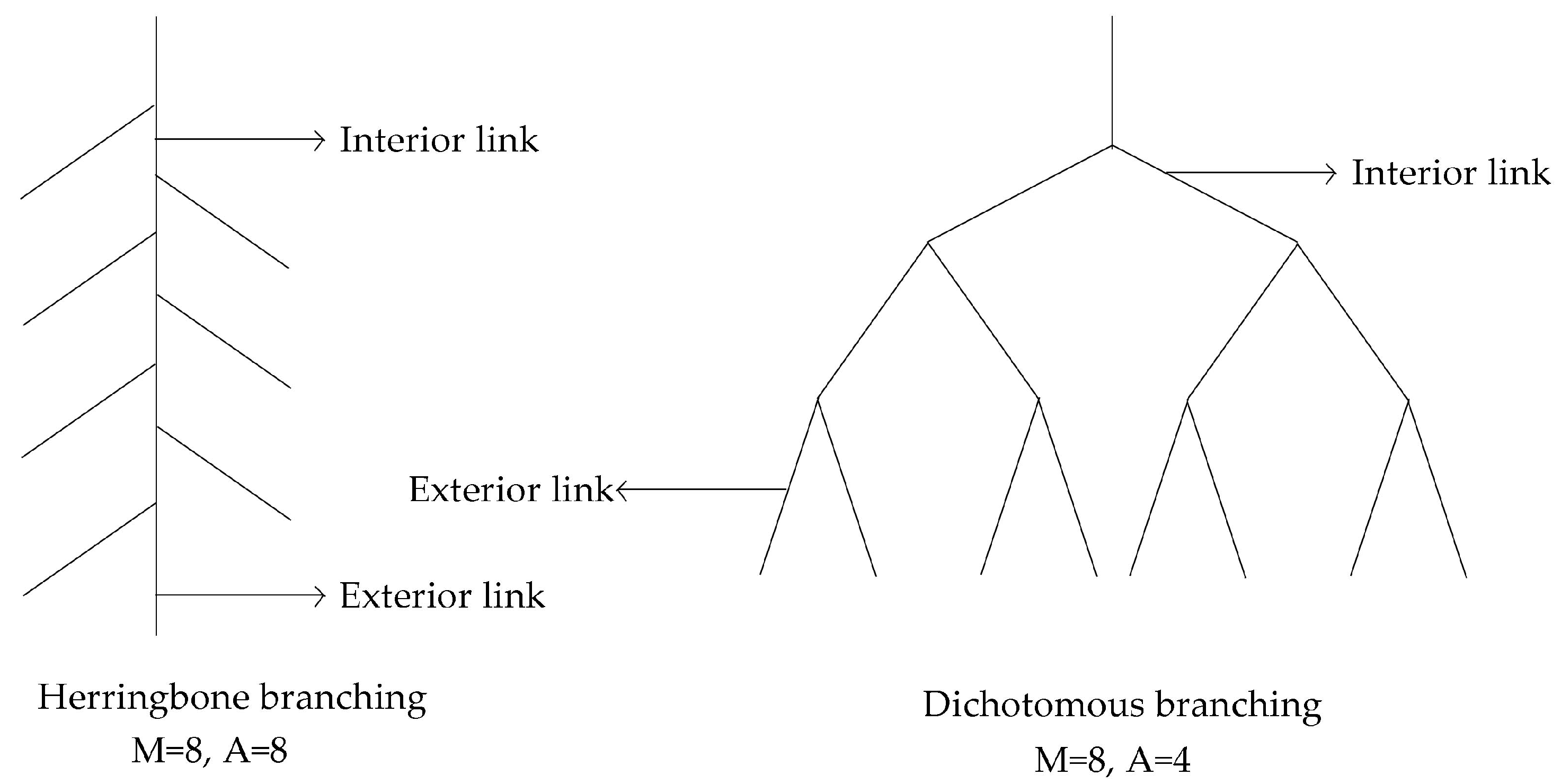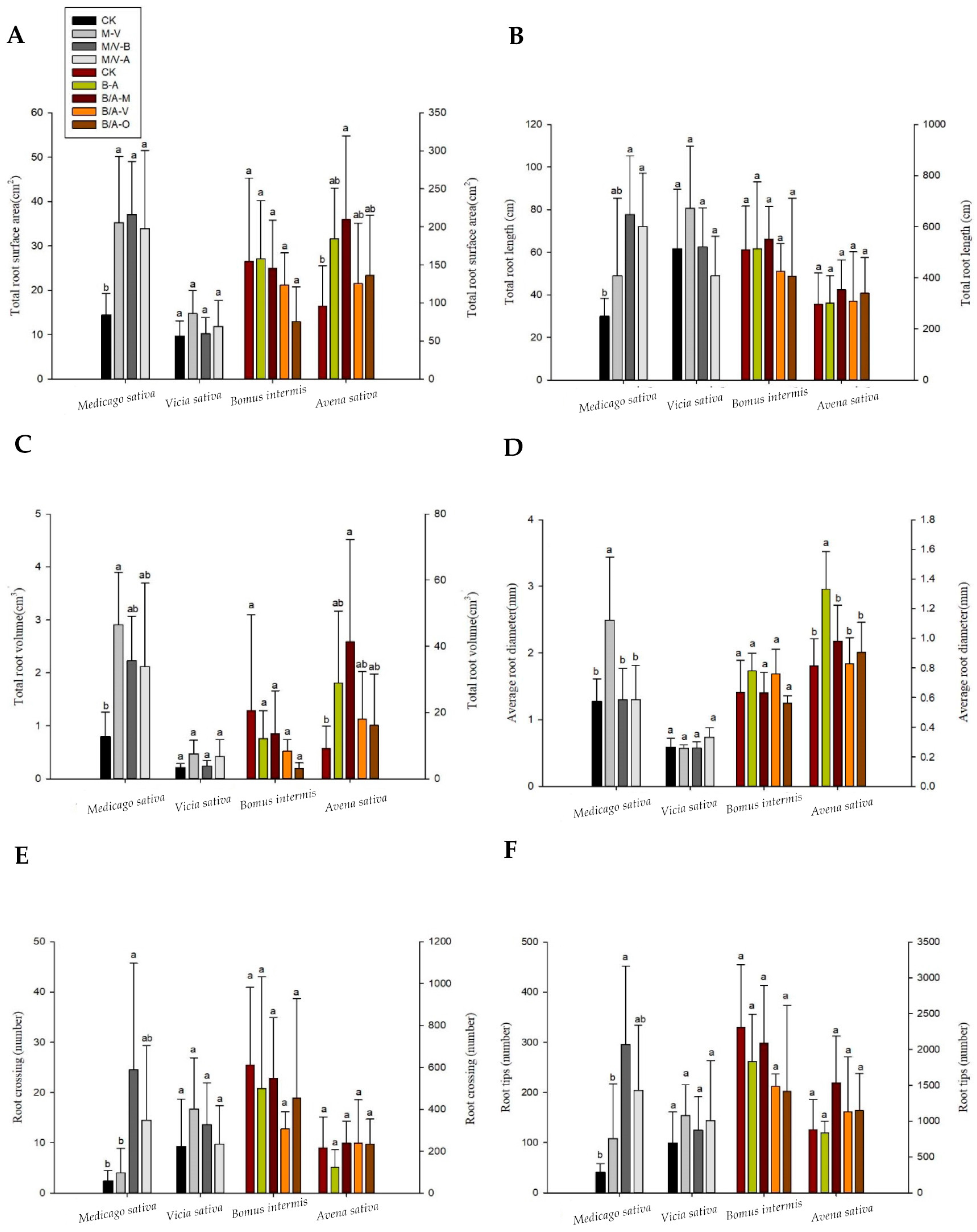Root Architecture of Forage Species Varies with Intercropping Combinations
(This article belongs to the Section Agroecology Innovation: Achieving System Resilience)
Abstract
1. Introduction
2. Materials and Methods
2.1. Experimental Location
2.2. Experimental Design
- Sole Medicago sativa (M)
- Sole Vicia sativa (V)
- Sole Bromus inermis (B)
- Sole Avenia sativa (A)
- Sole Onobrychis viciaefolia (O)
- M-V
- M/V-B (M-B or V-B)
- M/V-A (M-A or V-A)
- B-A
- B/A-M (B-M or A-M)
- B/A-V (B-V or A-V)
- B/A-O (B-O or A-O)
2.3. Measurement of the Root Parameters
2.4. Data Processing
3. Results
3.1. Comparison of Morphological Parameters of Forage Roots under Different Intercropping Modes
3.2. Comparison of the Topological Structure of the Forage Root System under Different Intercropping Modes
3.3. The Relationship between Root Morphological Parameters and Root Topological Structure under Different Intercropping Modes
4. Discussion
4.1. Effects of Different Intercropping Patterns on Root Geometry
4.2. Effects of Different Intercropping Patterns on the Root Architecture
5. Conclusions
Author Contributions
Funding
Acknowledgments
Conflicts of Interest
References
- Colombi, T.; Torres, L.C.; Walter, A.; Keller, T. Feedbacks between soil penetration resistance, root architecture and water uptake limit water accessibility and crop growth—A vicious circle. Sci. Total Environ. 2018, 626, 1026–1035. [Google Scholar] [CrossRef] [PubMed]
- Fitter, A.H. An architectural approach to the comparative ecology of plant root systems. N. Phytol. 1987, 106, 61–77. [Google Scholar] [CrossRef]
- Fitter, A.H.; Stickland, T.R.; Harvey, M.L.; Wilson, G.W. Architectural analysis of plant root systems 1. Architectural correlates of exploitation efficiency. N. Phytol. 1991, 118, 375–382. [Google Scholar] [CrossRef]
- Sun, J.; Zhao, X.; Fang, Y.; Xu, W.; Gao, F.; Zhao, W.; Fu, Q.; Xia, J. Root growth and architecture of Tamarix chinensis in response to the groundwater level in the Yellow River Delta. Mar. Pollut. Bull. 2022, 179, 113717. [Google Scholar] [CrossRef] [PubMed]
- Sun, J.; Zhao, X.; Fang, Y.; Gao, F.; Wu, C.; Xia, J. Effects of water and salt for groundwater-soil systems on root growth and architecture of Tamarix chinensis in the Yellow River Delta, China. J. For. Res. 2022, 34, 441–452. [Google Scholar] [CrossRef]
- Salim, M.; Chen, Y.; Ye, H.; Nguyen, H.T.; Solaiman, Z.M.; Siddique, K.H.M. Screening of Soybean Genotypes Based on Root Morphology and Shoot Traits Using the Semi-Hydroponic Phenotyping Platform and Rhizobox Technique. Agronomy 2021, 12, 56. [Google Scholar] [CrossRef]
- Amombo, E.; Li, H.; Fu, J. Research Advances on Tall Fescue Salt Tolerance: From Root Signaling to Molecular and Metabolic Adjustment. J. Amer. Soc. Hort. Sci. 2017, 142, 337–345. [Google Scholar] [CrossRef]
- Walk, T.C.; Van Erp, E.; Lynch, J.P. Modelling Applicability of Fractal Analysis to Efficiency of Soil Exploration by Roots. Ann. Bot. 2004, 94, 119–128. [Google Scholar] [CrossRef]
- Tilman, D.; Lehman, C.L.; Thomson, K.T. Plant diversity and ecosystem productivity: Theoretical considerations. Proc. Natl. Acad. Sci. USA 1997, 94, 1857–1861. [Google Scholar] [CrossRef]
- Fargione, J.; Tilman, D. Niche differences in phenology and rooting depth promote coexistence with a dominant C4 bunchgrass. Oecologia 2005, 143, 598–606. [Google Scholar] [CrossRef]
- Reynolds, J.; Bell, M.M.; Grace, J.; Gratton, C.; Jackson, R.D.; Keeley, K.O.; Mayerfeld, D. An agroecological vision of perennial agriculture. Agroecol. Sustain. Food Syst. 2021, 45, 1470–1479. [Google Scholar] [CrossRef]
- Kautz, T.; Stumm, C.; Kösters, R.; Köpke, U. Effects of perennial fodder crops on soil structure in agricultural headlands. J. Plant Nutr. Soil Sci. 2010, 173, 490–501. [Google Scholar] [CrossRef]
- La Guardia Nave, R.; Corbin, M.D. Forage Warm-Season Legumes and Grasses Intercropped with Corn as an Alternative for Corn Silage Production. Agronomy 2018, 8, 199. [Google Scholar] [CrossRef]
- Justes, E.; Bedoussac, L.; Dordas, C.; Frak, E.; Louarn, G.; Boudsocq, S.; Journet, E.-P.; Lithourgidis, A.; Pankou, C.; Zhang, C.J.F.o.A.S.; et al. The 4C approach as a way to understand species interactions determining intercropping productivity. Front. Agric. Sci. Eng. 2021, 8, 3. [Google Scholar]
- Ren, Y.Y.; Wang, X.L.; Zhang, S.Q.; Palta, J.A.; Chen, Y.L. Influence of spatial arrangement in maize-soybean intercropping on root growth and water use efficiency. Plant Soil 2016, 415, 131–144. [Google Scholar] [CrossRef]
- Schenk, H.J. Root competition: Beyond resource depletion. J. Ecol. 2006, 94, 725–739. [Google Scholar] [CrossRef]
- Esnarriaga, D.N.; Mariotti, M.; Cardelli, R.; Arduini, I. The Importance of Root Interactions in Field Bean/Triticale Intercrops. Plants 2020, 9, 1474. [Google Scholar] [CrossRef]
- Lu, B.; Qian, J.; Hu, J.; Wang, P.; Jin, W.; Tang, S.; He, Y.; Zhang, C. The role of fine root morphology in nitrogen uptake by riparian plants. Plant Soil 2022, 472, 527–542. [Google Scholar] [CrossRef]
- Olasantan, F.O. Effects of preceding maize (Zea mays) and cowpea (Vigna unguiculata) in sole cropping and intercropping on growth, yield and nitrogen requirement of okra (Abelmoschus esculentus). J. Agric. Sci. 1998, 131, 293–298. [Google Scholar] [CrossRef][Green Version]
- Nilahyane, A.; Islam, M.A.; Mesbah, A.O.; Garcia y Garcia, A. Effect of Irrigation and Nitrogen Fertilization Strategies on Silage Corn Grown in Semi-Arid Conditions. Agronomy 2018, 8, 208. [Google Scholar] [CrossRef]
- Elsalahy, H.; Bellingrath-Kimura, S.; Kautz, T.; Döring, T. Effects of mixing two legume species at seedling stage under different environmental conditions. PeerJ 2021, 9, e10615. [Google Scholar] [CrossRef] [PubMed]
- Bouma, T.J.; Nielsen, K.L.; Van Hal, J.; Koutstaal, B. Root system topology and diameter distribution of species from habitats differing in inundation frequency. Funct. Ecol. 2001, 15, 360–369. [Google Scholar] [CrossRef]
- Fitter, A.H. Architecture and Biomass Allocation as Components of the Plastic Response of Root Systems to Soil Heterogeneity. In Exploitation of Environmental Heterogeneity by Plants; Caldwell, M.M., Pearcy, R.W., Eds.; Academic Press: Boston, MA, USA, 1994; pp. 305–323. [Google Scholar] [CrossRef]
- Oppelt, A.L.; Kurth, W.; Jentschke, G.; Godbold, D.L. Contrasting rooting patterns of some arid-zone fruit tree species from Botswana—I. Fine root distribution. Agrofor. Syst. 2005, 64, 1–11. [Google Scholar] [CrossRef]
- Freschet, G.T.; Pagès, L.; Iversen, C.M.; Comas, L.H.; Rewald, B.; Roumet, C.; Klimešová, J.; Zadworny, M.; Poorter, H.; Postma, J.A.; et al. A starting guide to root ecology: Strengthening ecological concepts and standardising root classification, sampling, processing and trait measurements. New Phytol. 2021, 232, 973–1122. [Google Scholar] [CrossRef]
- Aber, J.D.; Melillo, J.M.; Nadelhoffer, K.J.; McClaugherty, C.A.; Pastor, J. Fine root turnover in forest ecosystems in relation to quantity and form of nitrogen availability: A comparison of two methods. Oecologia 1985, 66, 317–321. [Google Scholar] [CrossRef] [PubMed]
- Guo, E.; Gu, H.; Zhang, R.; Yang, X. Root architecture characteristics of five natural homogeneous grasslands in riparian buffers from lower reaches of Yellow River. Grassl. Sci. 2022, 68, 301–309. [Google Scholar] [CrossRef]
- Fransen, B.; Blijjenberg, J.; de Kroon, H. Root morphological and physiological plasticity of perennial grass species and the exploitation of spatial and temporal heterogeneous nutrient patches. Plant Soil 1999, 211, 179–189. [Google Scholar] [CrossRef]
- Belkacem El, A. Exploring the importance of root architecture plasticity in plant adaptation to environmental constraints. Plant Species Biol. 2023. [Google Scholar] [CrossRef]
- Zhiyong, Z.; Baomin, F.; Chao, S.; Xiaoxian, Z.; Qingwen, Z.; Bing, Y. Advances in Root System Architecture: Functionality, Plasticity, and ResearchMethods. J. Resour. Ecol. 2023, 14, 15–24. [Google Scholar] [CrossRef]
- Balduzzi, M.; Binder, B.M.; Bucksch, A.; Chang, C.; Hong, L.; Iyer-Pascuzzi, A.S.; Pradal, C.; Sparks, E.E. Reshaping Plant Biology: Qualitative and Quantitative Descriptors for Plant Morphology. Front. Plant Sci. 2017, 8, 117. [Google Scholar] [CrossRef]
- Taub, D.R.; Goldberg, D. Root System Topology of Plants from Habitats Differing in Soil Resource Availability. Funct. Ecol. 1996, 10, 258. [Google Scholar] [CrossRef]
- Li, S.; Wan, L.; Nie, Z.; Li, X. Fractal and Topological Analyses and Antioxidant Defense Systems of Alfalfa (Medicago sativa L.) Root System under Drought and Rehydration Regimes. Agronomy 2020, 10, 805–826. [Google Scholar] [CrossRef]
- Tatsumi, J.; Yamauchi, A.; Kono, Y. Fractal Analysis of Plant Root Systems. Ann. Bot. 1989, 64, 499–503. [Google Scholar] [CrossRef]
- Yang, Z.; Zhao, J.; Ni, H.; Wang, H.; Zhou, B. Three Subtropical Species Adapt to Drought by Reallocating Biomass and Adjusting Root Architecture. Forests 2023, 14, 806. [Google Scholar] [CrossRef]
- Chun, H.C.; Lee, S.; Choi, Y.D.; Gong, D.H.; Jung, K.Y. Effects of drought stress on root morphology and spatial distribution of soybean and adzuki bean. J. Integr. Agric. 2021, 20, 2639–2651. [Google Scholar] [CrossRef]
- Eshel, A. On the fractal dimensions of a root system. Plant Cell Environ. 1998, 21, 247–251. [Google Scholar] [CrossRef]
- Izumi, Y.; Iijima, M. Fractal and Multifractal Analysis of Cassava Root System Grown by the Root-Box Method. Plant Prod. Sci. 2002, 5, 146–151. [Google Scholar] [CrossRef]
- Liu, Y.; Bortier, M.F.; De Boeck, H.J.; Nijs, I. Root distribution responses to three-dimensional soil heterogeneity in experimental mesocosms. Plant Soil 2017, 421, 353–366. [Google Scholar] [CrossRef]
- Adams, C.B.; Reyes-Cabrera, J.; Nielsen, J.; Erickson, J.E. Root system architecture in genetically diverse populations of grain sorghum compared with shallow and steeply rooted monocultures. Crop Sci. 2020, 60, 2709–2719. [Google Scholar] [CrossRef]
- Alaguero-Cordovilla, A.; Gran-Gómez, F.; Tormos-Moltó, S.; Pérez-Pérez, J. Morphological Characterization of Root System Architecture in Diverse Tomato Genotypes during Early Growth. Int. J. Mol. Sci. 2018, 19, 3888. [Google Scholar] [CrossRef]




Disclaimer/Publisher’s Note: The statements, opinions and data contained in all publications are solely those of the individual author(s) and contributor(s) and not of MDPI and/or the editor(s). MDPI and/or the editor(s) disclaim responsibility for any injury to people or property resulting from any ideas, methods, instructions or products referred to in the content. |
© 2023 by the authors. Licensee MDPI, Basel, Switzerland. This article is an open access article distributed under the terms and conditions of the Creative Commons Attribution (CC BY) license (https://creativecommons.org/licenses/by/4.0/).
Share and Cite
Liu, X.; Jiao, Y.; Zhao, X.; Yu, X.; Zhang, Q.; Li, S.; Ma, L.; Tang, W.; Yang, C.; Yang, G.; et al. Root Architecture of Forage Species Varies with Intercropping Combinations. Agronomy 2023, 13, 2223. https://doi.org/10.3390/agronomy13092223
Liu X, Jiao Y, Zhao X, Yu X, Zhang Q, Li S, Ma L, Tang W, Yang C, Yang G, et al. Root Architecture of Forage Species Varies with Intercropping Combinations. Agronomy. 2023; 13(9):2223. https://doi.org/10.3390/agronomy13092223
Chicago/Turabian StyleLiu, Xindi, Yu Jiao, Xiaoyu Zhao, Xiaoxu Yu, Qingping Zhang, Shuo Li, Lichao Ma, Wei Tang, Chao Yang, Guofeng Yang, and et al. 2023. "Root Architecture of Forage Species Varies with Intercropping Combinations" Agronomy 13, no. 9: 2223. https://doi.org/10.3390/agronomy13092223
APA StyleLiu, X., Jiao, Y., Zhao, X., Yu, X., Zhang, Q., Li, S., Ma, L., Tang, W., Yang, C., Yang, G., Sun, J., & Miao, F. (2023). Root Architecture of Forage Species Varies with Intercropping Combinations. Agronomy, 13(9), 2223. https://doi.org/10.3390/agronomy13092223







